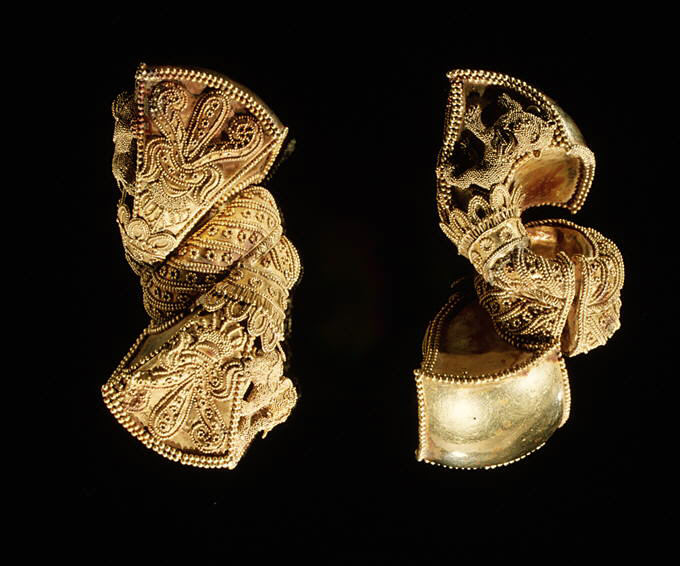Economies of Ancient India
Since early times, India has held an important position between major trading powers like Europe, China, and the Middle East. Its great agricultural wealth, large population, luxury resources, and convenient ports have always supported trade and industry. The Indus Valley Civilization, which began around 3,000 BCE, built organized cities like Harappa and Mohenjo-Daro. Mohenjo-Daro in particular is remembered as a center of trade. Its major exports included cotton and wool textiles and pottery, as well as crop surpluses. The city declined along with its civilization, paving the way for the more pastoral society of the Aryan Vedic era.
The Vedic kingdoms of India still conducted trade, but they appear to have valued agriculture highly. Their major industry was the raising of cattle, an animal still revered in India today. Textiles remained an important commodity, now including leather. Each village, town, and city operated somewhat autonomously, with its own guilds of merchants and craftsmen. Horses, oxen, and elephants provided transportation and assistance in farming. When silk began to trickle in from China, Indian artisans quickly learned to weave and dye with the fabric. Trade with the Greeks and Romans proved especially profitable. Spices, ivory, gems, indigo, textiles, sugar, and live animals like tigers and elephants all grew to be popular exports.
Medieval India and the Silk Road
Indian merchants conducted trade by both land and sea. During the medieval era, land routes along the Silk Road became especially important in the flow of goods between East and West. Caravans carried goods to and from Indian ports, bringing wealth with them. For the common people, however, this era was marked by an increase in feudalistic policies. After the fall of the Gupta Empire, small, warring kingdoms fought against each other and outside invaders. They required extensive resources to feed and equip their armies. Eventually, nearly all of India fell under the control of Central Asian sultanates.
Economy of the Mughal Empire
The most influential of these Islamic states was the Mughal dynasty, which reigned from 1526 to 1857. The Mughals, like the medieval lords before them, relied on their large agricultural base to fuel a militaristic and often materialistic empire. For the most part, the Indian subcontinent remained divided between semi-autonomous states. Silver, the basis of their economy, flowed in abundance from European mines in the Americas. The Mughals, centered in Delhi, sat atop an immense funnel of wealth. Some of this surplus went to the lavish lifestyles of the nobility, as well as infrastructure and public monuments. The Taj Mahal, perhaps the most famous building in India, was built by Mughal ruler Shah Jahan in the 17th century.
Industry in British India
All of this wealth, and the weakening of the Mughals, attracted the attention of foreign interests. European powers like England, the Netherlands, and Portugal took to the seas to establish trading posts, which soon expanded into full colonies. By the time the British Empire had established a firm grip on the subcontinent, it was undergoing an industrial revolution at home. More than specialized industries, the British needed a massive agrarian base to feed its machines and people.
British India’s primary industries, besides food crops, lay in textiles, opium, and indigo. New railways and steamship connected its cities and shipped goods to the far corners of the British Empire. Opium was exported in bulk to China, where it could be exchanged for luxury items like ceramics and tea. While the East India Company and later businessmen of the empire enriched themselves, the people of India underwent multiple famines and generally experienced a loss in quality of life. Private industry that had existed long before British intervention withered in the face of unfair competition and new regulations. The devaluation of silver as a currency, the basis of the rupee, also negatively impacted India’s economy.
Modern Indian Economics
Following its independence from Britain, the economy of India has grown in uneven leaps and bounds. The nation inherited a large population of English-speaking workers, which has encouraged the growth of international service-based industries. India is now home to major technology and manufacturing centers, supporting a middle class of nearly 300 million people. Agriculture continues to support about half of its population. Significant wealth disparities exist between the wealthy and poor. Rural villages and poor urban workers may live without electricity and plumbing. An estimated 22 percent live below the poverty line, though this number has decreased in recent decades.
References
Charlesworth, Neil. British Rule and the Indian Economy 1800–1914. Macmillan International Higher Education. 1982.
Henderson, Carol. Culture and Customs of India. Greenwood Press. 2002.
Jayapalan, N. Economic History of India. Atlantic Publishers. 2008.
Majumdar, Ramesh Chandra. Ancient India. Motilal Banarsidass. 1977.
Raychaudhuri, Tapan, Dharma Kumar, Meghnad Desai, and Irfan Habib, eds. The Cambridge Economic History of India: Volume 1, C.1200-c.1750. Cambridge University Press. 1982.
Raychaudhuri, Tapan, Dharma Kumar, Meghnad Desai, and Irfan Habib, eds.* The Cambridge Economic History of India: Volume 2, C.1751-c.1970. *Cambridge University Press. 1983.
Richards, John F. The Mughal Empire. Part 1. Vol. 5. Cambridge University Press. 1995.
Robb, Peter. A History of India. Macmillan International. 2011.
Rothermund, Dietmar. An Economic History of India. Routledge. 2002.
Thapar, Romila. A History of India. Penguin UK. 1990.
“The World Factbook: India.” Central Intelligence Agency, Central Intelligence Agency, 9 Oct. 2018, www.cia.gov/library/publications/the-world-factbook/geos/in.html.
About TOTA
TOTA.world provides cultural information and sharing across the world to help you explore your Family’s Cultural History and create deep connections with the lives and cultures of your ancestors.



